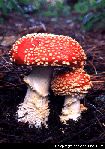Plants Poisonous to Livestock and other Animals
This is a growing reference that includes plant images, pictures of affected animals and presentations concerning the botany, chemistry, toxicology, diagnosis and prevention of poisoning of animals by plants and other natural flora (fungi, etc.).

Many original images were provided by Dr. Mary C. Smith of the Cornell College of Veterinary Medicine. Additional images, text and web pages by Dan Brown and staff. The students of Nutritional Toxicology (Animal Science 625) have also made large contributions through web pages created as term projects. The frequently asked questions is a compilation of some of the questions we have received via email over the years.
These pages are maintained by the Animal Science Department at Cornell University as a reference only. We have no physicians on staff to answer one-on-one questions about specific plants or poisons, especially as they apply to humans. We suggest you contact your local state or regional poison control center. For information on who to call or email in your area, visit Poison Control and Prevention Center Directory. Of course, if you have someone who has collapsed or has trouble breathing, you should call 911 before searching for a poison control center.
For questions regarding the accuracy of the content of these pages, contact Dan Brown .